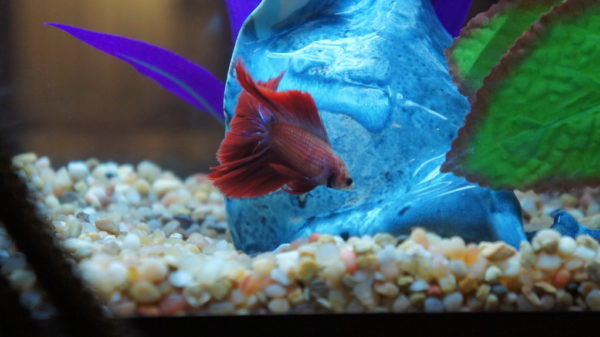Betta is a rare fish breed known for its vivid colors and long graceful fins. Many people choose Bettas as their first fish, but delicate critters require specific attention. Bettas have a reputation for being quite territorial. As a result, putting them in the same tank as other fish can be tricky if you don’t take the proper measures. When it comes to female Bettas, a male Betta might be violent. They may, however, get along if the suitable tank and introduction procedure are used.

know more about the betta fish series.
Short Answer
The short answer is yes, but only for a limited period of time. Betta fish are gorgeous and simple to care for, but they can be aggressive toward other fish, and many people worry if a male and a female can coexist. Male and female Bettas can coexist, but there are a few things to consider before putting them in the same tank and walking away. Continue reading to learn about the steps you’ll need to take to ensure that these two fish can coexist peacefully and potentially reproduce.
Table of Contents
Can Males & Females Live Together? – The Detailed Answer
If you have two tanks in your house, one with male Betta fish and the other with females, you should be able to put them together for a few hours while cleaning the other. You’ll have to pay attention to the fish and check for signs of aggression. If you’re new to bringing aggressive fish together, this two-tank setup can help you learn about your fish’s behavior, which is essential if you plan to breed them. Until you can tell when one Betta fish is getting hostile, we recommend keeping them in different aquariums.
Regrettably, long-term cohabitation of male and female Bettas will be difficult. Unless it’s mating season, the male perceives the female as a threat and likely acts hostile. During the mating rite, one fish may grow hostile toward the other, necessitating their separation.
Because the male will grow aggressive toward the female after she lays her eggs, and she may devour the eggs, you’ll need a third tank for breeding. The male may consume the eggs once they hatch and begin to swim, so it’s best to remove him after they hatch.
If your Bettas aren’t getting along, you’ll have to separate them. You have the option of keeping each fish in its aquarium or using a tank divider. Even if you use a division, your Betta may become anxious from constantly seeing each other. Dark-colored walls should be purchased to prevent fish in one portion from seeing fish in the neighboring section. This will make living in a sectioned tank more comfortable for them.
Can you put a male and female betta fish together in a large enough tank?

If you really want to nurture a male-female Betta pair together, you’ll need the correct tank. Bettas, as previously stated, are notoriously territorial. If you’re going to keep a Betta with another fish, you’ll need a tank that’s big enough. What size tank should you have? For two Bettas, a 15-gallon tank, a 20-gallon tank for three Bettas, a 25-gallon tank for four Bettas, and a 30-gallon tank for five Bettas is advised. Even if you just intend to keep one Betta, the tank must be at least 10 gallons. The tank must be at least 15 gallons if you’re trying to keep a male-female pairing around each other.
Aside from having a large enough tank, your tank should also have plenty of plants and decorations to give your Betta a place of refuge and hide whenever they want to avoid the other Betta. Your fish will require solitude time if they have been exposed to others in their zone for an extended period. Your fish may quit eating and become ill if they become overly agitated. Make sure your Bettas have the proper tank, as their survival and well-being may rely on it.
What if you want to breed your male and female Betta fish?
The male and female will be introduced during the mating season, generally from spring to early summer. Your fish should be active, energetic, and between 4 and 11 months old for best fertility. Test the water often to ensure the tank is clear of ammonia, nitrites, and nitrates.
The temperature of the water should be 80 degrees Fahrenheit, with a pH of 6.5. If you want to lower the pH and soften the water, several experts recommend using an Indian Almond Leaf. Bubbles may be blown in the water by the males to guard the eggs. His color will also darken. Assemble the fish and keep an eye on them.
A plastic divider in the tank may help them become used to one another ‘s presence, allowing you to evaluate how they respond to each other. To attract the female’s interest, the male will most likely puff and flap his fins. The female’s hue will deepen as well, revealing her vertical lines. The egg patch behind her ventral fins may also be seen.
A fight should not be violent and should be over in a few minutes if they start fighting. When they are ready to breed, the fish will be pretty close to one another, and the male will fold over the female as she releases the eggs and he fertilizes them. Following that, the male will pursue the female and guard the eggs until they hatch. Choosing the right ones for mating is crucial because your Betta fish is rare to spawn in the first year.
For the highest likelihood of succeeding, go for the most active fish in the tank and the healthiest male. The female should be significantly shorter than the male, with smooth fins free of rough edges or injuries.
Ways to keep your male and female Bettas together
If you want to maintain a single male and female betta fish together, make sure your tank is not only large but also long. This will assist your female in staying away from your male if necessary, reducing the likelihood of aggressiveness between the two fish. In addition to maintaining them in a huge tank, you must provide them with plenty of plants and hiding spots. Your Betta’s line of sight should be continuously broken by foliage in your tank. In addition to plants, create caverns, driftwood, and decorations where your Bettas can build their territories. You can keep your male and female Bettas together in the following ways:
A tank divider
You may always use a tank divider to keep a male and female Betta together if you have a large enough tank. This will be helpful since they will never be able to interact directly with one another. You can still see them in your tank. Remember that female Bettas want a more excellent swimming room than male Bettas, so divide your tank so that your female has 10 gallons and your male has 5.
Condos for your Bettas
Betta enthusiasts sometimes use Betta condos to keep multiple males in a single aquarium. There is only one condo; it consists of a small container with partitions and a ventilated wall that allows water to circulate. It dangles inside the aquarium, essentially isolating any fish from the rest of the tank. The use of Betta condominiums is fraught with controversy. Single condominiums kept in different parts of the tank are permitted. However, any close visual proximity between betas causes them to flare into a battle position when they can see each other through transparent walls. Despite their small size, Bettas have a remarkable vision and compete with Bettas from another tank across the room!
Most Betta owners believe that the stress created by this abnormal intimacy can harm the fish’s health, shortening its lifespan. For such an extended period, fish in the wild rarely face rivals. Condos should have at least 12 to 15 inches of separation between the fish and plants to hide behind if the fish are grouped.
Sorority for your Bettas
Instead of introducing all the fish at once, you should always add a male Betta to a sorority. If you introduce all the fish at once, the possibilities of hostility skyrocket, so you’re more likely to introduce an overly aggressive Betta unintentionally. Furthermore, the bioload will be too great for the bacteria in your tank to handle.
There will be a massive ammonia increase, which could cause ammonia poisoning in one or more of your fish. Remove all the ladies from the tank once you’ve established a sorority, reorganize it, and then reintroduce them all with your freshly acquired male. While some indicators of hostility may appear at first, they will not be quite as severe. There will be no defined territories once they’ve been reintroduced to the tank, and they’ll be too preoccupied with finding new ones to fight amongst themselves.
Territories and Hiding Places

Adding several hiding spots and territories for your fish is one of the secrets to making this work properly. You’ll need a lot of plants in your tank to assist break up the lines of sight and provide hiding spots for the fish. In addition to plants, Caves are an excellent choice since they offer a haven for your Bettas to hide from what’s going on behind them. Finally, driftwood and other decorations can be used to add life to your tank while also providing safe havens for all of your fish.
Wrapping Up
Unfortunately, during mating season, your male and female Betta can only live together for a limited time, and even then, you must keep a watchful eye on them. We recommend staying away from it unless you’re breeding and using one of the many Betta-friendly breeds, such as Neon Tetras. These additional fish can give you peace of mind as well as a variety of colors. You’ll need to camp outside the tank while the fish are together if you’re breeding, especially if you don’t have much experience.
To know if you can keep your Betta fish in a bowl without a filer, click here.
